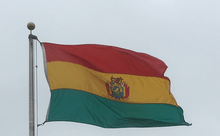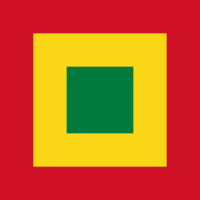Flag of Bolivia
The national flag of Bolivia was originally adopted in 1851. The state and war flag is a horizontal tricolor of red, yellow and green with the Bolivian coat of arms in the center. According to one source, the red stands for Bolivia's brave soldiers, while the green symbolizes fertility and yellow the nation's mineral deposits. Along with the Dominican Republic, Haiti, Afghanistan, Ecuador, Costa Rica, and El Salvador it is one of six national flags in the world which has a depiction of its flag within the flag itself.

.svg.png) | |
| Name | La Tricolor "The tricolor" (in Spanish) |
|---|---|
| Use | State and war flag |
| Proportion | 15:22 |
| Adopted | October 31, 1851 |
| Design | A horizontal tricolor of red, yellow and green with the coat of arms |
 Variant flag of Bolivia | |
| Use | Civil flag |
| Proportion | 15:22 |
| Adopted | October 31, 1851 |
| Design | A horizontal tricolor of red, yellow and green |
 Dual flag | |
| Names | Wiphala, banner of the Qulla Suyu |
| Use | National flag |
| Proportion | 1:1 |
| Adopted | February 7, 2009 |
| Design | Banner composed of a 7-by-7 square patchwork in seven colours, arranged diagonally. |
 Maritime Claim Flag | |
| Use | Naval ensign |
| Proportion | 2:3 |
 Naval Jack | |
| Name | Naval jack |
| Proportion | 1:1 |
| Design | A red, yellow and green square |

Since 2009 the Wiphala also holds the status of dual flag in the country.
Overview
According to the revised Constitution of Bolivia of 2009, the Wiphala is considered a national symbol of Bolivia (along with the flag, national anthem, coat of arms, the cockade; kantuta flower and patujú flower).[1]
Despite its landlocked status, Bolivia has a naval ensign used by navy vessels on rivers and lakes. It consists of a blue field with the state flag in the canton bordered by nine small yellow five-pointed stars, with a larger yellow five-pointed star in the fly. The nine small stars represent the nine departments of Bolivia, and the larger star the nation's right to access the sea (access that it lost in 1884 in the War of the Pacific).
Description
Design and dimensions
The national flag of Bolivia is described as a tricolor rectangle, with the colors red, yellow and green, in a ratio of 1:1:1, meaning three horizontal bands, with the red on the superior part occupying a third of the flag's width, yellow in the middle band using the same width, and green in the inferior part, using the last third.[2]
The dimensions of the flag had not been defined since its adoption in 1851. Supreme Decree No. 27630 of 2004 finally established that the size of the national flag be of 7.5 squares width by 11 squares long, a square can be any size, but always using the ratio 15:22.
Color and symbolism
The first description of Bolivia's national flag, together with the significance of these, were first established by the Supreme Decree of 1888 during the government of President Gregorio Pacheco, which specifies that:
- Red: "represents the blood shed by our heroes for the birth and preservation of the Republic"
- Yellow: "represents our wealth and resources."
- Green: "represents the richness of our natural areas as well as hope, a foundational value of our society"
The exact colors of the Bolivian flag have been established by the Supreme Decree of 2004:[3]
| Color model | Red | Yellow | Green |
|---|---|---|---|
| Pantone | 485[4] | Process Yellow[4] | 356[4] |
| RGB (hex) | 218, 41, 28 (#DA291C)[5] | 244, 228, 0 (#F4E400)[6] | 0, 122, 51 (#007A33)[7] |
| CMYK | C0 M95 Y100 K0[5] | C0 M0 Y100 K0[6] | C91 M0 Y100 K26[7] |
The colours of the tricolor can also be found in the Bolivian Wiphala. The Wiphala has been included into the national colours of the Bolivian Air Force such as on the executive Dassault Falcon 900EX.[8] The Wiphala is also officially flown on governmental buildings such as the Palacio Quemado and parliament alongside the tricolor since the introduction of the revised 2009 constitution.[9]
Historical flags
The current Bolivian flag has been officially adapoted 31st of October 1851 during the presidency of Manuel Isidoro Belzu.
According to Supreme Decree No. 27630 of July 19, 2004, during the presidency of Carlos Mesa, it was established that the civil flag used in civic, public and patriotic celebrations will be used without the National Shield, instead the flag used by the state in official acts it will include in its central part the shield
During the presidency of Evo Morales, through Supreme Decree No. 241 of August 5, 2009, some symbolic modifications were made the flag. It was also established that both the civil flag and the flag used by the State in official acts it will be raised on the right side and the wiphala on the left side
 Colonial flag, Spanish Empire flag (1506–1825/1821 in Peru, and Bolivia), (1506–1785/1701 in other colonies), (1506–1821 in Philippines)
Colonial flag, Spanish Empire flag (1506–1825/1821 in Peru, and Bolivia), (1506–1785/1701 in other colonies), (1506–1821 in Philippines).svg.png) Bandera Menor, Civil flag (1825–1826)
Bandera Menor, Civil flag (1825–1826).svg.png) Bandera Mayor, State flag (1825–1826)
Bandera Mayor, State flag (1825–1826).png) Bandera Menor, Civil flag (1826–1831)
Bandera Menor, Civil flag (1826–1831).png) Bandera Mayor, State flag (1826–1831)
Bandera Mayor, State flag (1826–1831).svg.png) Bandera Menor, Civil flag (1831–1851)
Bandera Menor, Civil flag (1831–1851).svg.png) Bandera Mayor, State flag (1831–1851)
Bandera Mayor, State flag (1831–1851) Peru-Bolivian Confederation (1836–1839)
Peru-Bolivian Confederation (1836–1839)
.svg.png) Former naval ensign of Bolivia (1966-2013)
Former naval ensign of Bolivia (1966-2013).svg.png) Armed Forces flag
Armed Forces flag
See also
References
- "Artículo 6. II. Los símbolos del Estado son la bandera tricolor rojo, amarillo y verde; el himno boliviano; el escudo de armas; la wiphala; la escarapela; la flor de la kantuta y la flor del patujú." (Article 6. II. State symbols are the flag tricolor red, yellow and green; the Bolivian national anthem; coat of arms; the wiphala; the cockade; the flower of kantuta and the flower of patujú.) Constitution of Bolivia Archived 2017-10-24 at the Wayback Machine
- "Bandera de Bolivia". Bolivia.com. Retrieved 12 October 2014.
- DeveNet S.R.L./LexiVox. "Bolivian Flag". Lexivox.org. Retrieved 12 October 2014.
- "Gaceta Oficial del Estado Plurinacional de Bolivia" (in Spanish). Retrieved July 10, 2020.
- "PANTONE 485 C - Find a Pantone Color". Retrieved July 10, 2020.
- "PANTONE Process Yellow C - Find a Pantone Color". Retrieved July 10, 2020.
- "PANTONE 356 C - Find a Pantone Color". Retrieved July 10, 2020.
- "Photos: Dassault Falcon 900EX Aircraft Pictures - Airliners.net". Airliners.net. Retrieved 12 October 2014.
- "Por decreto, el Ejecutivo fija dos fechas fechas de fundación del país". Eju.tv. Retrieved 12 October 2014.
External links

- Bolivia at Flags of the World